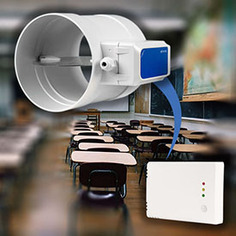EU declaration conformity
CO2 controller | wall mounting | LED indicators | 24 V DC-PoM
Product description
This device is a single-output controller that manages ventilation systems and fan speed by measuring temperature, humidity, and CO2.
Measurement & Control: It measures temperature, humidity, CO2, and ambient light. It provides EC/AC fan or damper actuator control with a single analog output (various types available). You can select ranges and control fan speed based on these parameters. Ventilation management is also possible based on occupancy using an ambient light sensor (with night/day detection).
Power & Connectivity: It operates on 24 V DC and can be connected via spring terminals or RJ45.
Communication & Customization: All data and settings are accessible via Modbus RTU. It includes firmware updates (bootloader) and a replaceable CO2 sensor element. The light intensity of the LED status indicators is adjustable
Documents
Additional specifications and description
People produce CO2 or carbon dioxide while breathing. That makes CO2 concentration a good indicator for the occupancy and activity level in a space. In many applications, CO2 sensors are used as an indicator for the ventilation requirements. This HVAC transmitter offers a clear, visual indication of the CO2 level via the green, yellow and red LED. The green LED indicates that the CO2 level is within range - there is sufficient fresh air supply. When the CO2 level enters the alert range, the yellow LED lights up. Red means that CO2 levels are too high or that there is insufficient fresh air supply. The measured temperature, relative humidity, CO2 and ambient light level are available via Modbus RTU. Photoacoustic sensing technology is used here to measure the CO2 level. This makes the sensor very sensitive and specific, making it useful for the detection of various gases. The use of specific infrared wavelengths that correspond to CO2 absorption lines ensures that interference from other gases is minimised.

This sensor offers you the choice to connect it via the cage clamp terminal blocks or via the RJ45 connector. Supply voltage and Modbus RTU communication can be connected via the RJ45 connector. Via the terminal blocks it is possible to connect the outputs, Modbus RTU communication and the supply voltage. Never connect the supply voltage via the RJ45 connector and the terminal blocks simultaneously. The supply voltage is 24 V DC. The ground terminals of the power supply (V-) and output (GND) are internally not connected. This means that a 4-wire cable is required to connect this sensor. Most 24 V DC power supplies offer protection against short circuit, overload and overvoltage. A 24 V DC supply voltage increases the safety and reliability of your installation.
The ABC logic self-calibrating algorithm is by default enabled. This algorithm is designed to be used in applications where CO2 concentrations will drop to outside ambient conditions (400 ppm) at least once (15 minutes) in a 7day period, which is typically seen during unoccupied periods. The sensor will reach its operational accuracy after 25 hours of continuous operation at a condition that it was exposed to ambient reference levels of air at 400 ppm ± 10 ppm CO2.
The enclosure offers an IP30 protection against ingress of dust and moisture. It can be mounted on a wall indoors. To ensure optimal performance, it should be protected from direct sunlight.







.webp)
.webp)
.webp)
.webp)
.webp)
.webp)
Remarks, reviews & ratings